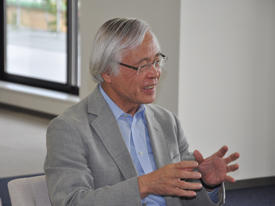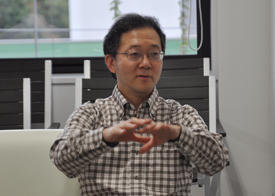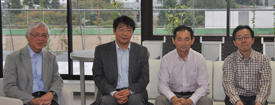

11/26/2012

Since its launch in 2007, the AIMR has unwaveringly encouraged materials scientists with different backgrounds, expertise and research interests to work together. “This approach stems from the idea that it is not sufficient to gather a collection of excellent researchers to achieve truly original research,” explains Masaru Tsukada, the AIMR’s administrative director. “Much can be learnt from crossing frontiers,” says Mingwei Chen, the Target Project (TP) leader of the Non-equilibrium Materials project. Entering the second 5-year phase of its development, the AIMR is building on its ongoing ‘fusion research’ by taking another significant step: incorporating mathematics.
The AIMR has established three ‘target projects’ (TPs) that combine materials science research expertise with topics of interest to mathematicians — namely, Non-equilibrium Materials Based on Mathematical Dynamical Systems, Topological Functional Materials and Multi-scale Hierarchical Materials Based on Discrete Geometrical Analysis.
Chen explains that a good understanding of non-equilibrium phenomena relies on mathematic dynamics. Tadafumi Adschiri, the TP leader of Multi-scale Hierarchical Materials, agrees: “What we are embarking on with our mathematician colleagues is the analysis of the materials’ properties — from our characterization, but from a mathematics point of view.” A longer-term goal is to close the loop back from mathematics to materials, and use the models to predict which materials should be synthesized for specific uses.

Hierarchical materials are also particularly intriguing for mathematicians, as understanding the behavior of atoms does not easily translate into an understanding of a material’s properties. Taro Hitosugi, sub-leader of the Multi-scale Hierarchical Materials project, elaborates: “As the atoms aggregate into clusters and extended materials, different properties emerge — in the same way that cells form organs, and organs form human bodies. What we are now trying to do, together with mathematicians, is to establish a link between the atoms (discrete points) and the bulk material (a continuum).”
This mathematics-driven approach may lead to a conceptual revolution of the research interests of topological functional materials. Katsumi Tanigaki, the TP leader of the Topological Functional Materials project, works on semiconductors, for which inorganic materials such as silicon have traditionally been used. With flexible semiconductor devices being touted as the next technological target, inorganic-based semiconductors may no longer be the best choice. “For big changes we need new ideas, both from theory and experiments,” says Tanigaki. “We are now trying to use organic-based semiconductors for spintronics as well as electroluminescent devices in place of inorganic semiconductors, and we have had some success. The theory part is where we’ll work with mathematicians.”
“The AIMR’s mathematics-driven strategy provides an important framework which guides the projects in a particular direction,” Tanigaki continues. “This is a challenging approach that may well enable us to find something very original and exciting. Marrying materials with mathematics like this is a brand-new area.”

In the target projects, the traditional approach to collaboration is reversed: the mathematicians and materials scientists first team up together, then search for a common interest and identify a project that can benefit both parties.
Even when a suitable project has been identified, challenges can arise. Specialist terminology, for example, varies across the disciplines, which can hinder communication. To address this, the AIMR hosts a series of informal, interdisciplinary team meetings where researchers can learn more about each other’s discipline and research interests. When each member presents their own research, common interests and novel research avenues emerge. In the Multi-Scale Hierarchical Materials project, for example, Hitosugi is fascinated by interfaces at the atomic level whereas other project members are interested in the continuum of bulk properties. “These differences, and how to get past them, is the essence of the target program,” he says. “It is a good chance for us to go in a totally new direction.”
The AIMR has also enlisted the help of ‘interface researchers’, theoretical physicists and chemists who do not belong to any specific research laboratory, but can freely collaborate with any group. According to Adschiri, they play the most important role in bridging the gap between disciplines. Tsukada explains: “They can communicate efficiently with both parties, thus efficiently conveying messages and connecting people.” New to the AIMR, these independent researchers are already facilitating communication.

Concomitantly, working on the target projects has started to influence the researchers’ methods in their own, more ‘conventional’ research.
Tanigaki notes that this unusual collaboration is already impacting the way his team works — before they characterized materials and looked for ways to improve them, but now they employ modeling as well. He adds: “What interests mathematicians in topological materials are the topology and geometry aspects, not whether it is inorganic or organic, and working with this in mind is very interesting.”
Chen is also excited that he has been able to expand his work, modeling a variety of glasses and working towards establishing some universal rules. “By broadening our interests we have also started to work on porosity — a pretty intriguing new direction,” he says.
Such interdisciplinary research provides invigorating challenges, especially for younger researchers who are still establishing their own research progression.
“We are waiting for that big result that will be our success story,” says Tanigaki. As such major achievements usually take years or decades of research, the AIMR’s 5-year mathematics-focused initiative presents AIMR researchers with another challenge as they aim to produce results in a compressed timeframe. Each year the TPs are required to achieve fixed goals, and the AIMR monitors their progress in reaching these annual targets. In these early stages, it is encouraging that some milestones have already been reached and joint papers between materials scientists and mathematicians have been published.

“All researchers agree that the AIMR is embarking on a bold strategy and it is difficult to forecast the results,” summarizes Chen. Tsukada agrees that it is a very ambitious project, something that the program committee members of the World Premier International (WPI) Research Center Initiative recognize. “It is a challenge, but we believe it will lead to some utterly original and excellent research,” says Tsukada.